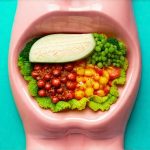Our modern food environment is drastically different from that of even a few generations ago. Highly processed foods, characterized by long shelf lives and appealing flavors, have become commonplace in many diets. While convenience and palatability are attractive features, these foods often contain artificial flavors and preservatives designed to enhance taste, appearance, and longevity. However, the increasing prevalence of these additives raises important questions about their impact on human health, specifically concerning the delicate ecosystem within our gut – the gut microbiome. This complex community of trillions of microorganisms plays a crucial role in digestion, immunity, mental wellbeing, and overall health; understanding how artificial ingredients affect this balance is vital for informed dietary choices.
The rise of processed food consumption coincides with an alarming increase in chronic diseases like obesity, inflammatory bowel disease, allergies, and even certain mental health disorders. While many factors contribute to these trends, a growing body of research suggests that disruptions to the gut microbiome – dysbiosis – are a significant underlying element. Artificial flavors and preservatives, designed to bypass our natural satiety signals and remain stable for extended periods, may inadvertently interfere with the delicate microbial balance within us, potentially contributing to this increasing disease burden. It’s not simply about avoiding “bad” ingredients; it’s about understanding how these additives interact with our internal ecosystem and what the long-term consequences might be. Understanding factors that contribute to conditions like gerd can help guide dietary choices.
Artificial Flavors: A Microbial Disruption
Artificial flavors are chemical compounds created in a lab to mimic natural flavors, often at a fraction of the cost. They’re used extensively across the food industry, from candies and beverages to savory snacks and processed meats. While generally considered “safe” by regulatory bodies, these compounds haven’t always been thoroughly evaluated for their impact on gut health. Many are designed to be highly palatable – meaning they strongly activate reward pathways in the brain – which can lead to overconsumption and altered eating behaviors. This, in itself, can indirectly impact the microbiome through changes in dietary patterns. However, research is emerging that suggests some artificial flavors may directly affect microbial composition and function.
- Studies have shown that certain artificial sweeteners (often used alongside flavors to enhance sweetness) can alter gut bacterial populations, potentially favoring strains associated with inflammation and metabolic dysfunction. This can lead to issues similar to those seen when antibiotics disrupt the gut flora.
- Some flavor compounds may act as prebiotics – substances that feed specific bacteria – but not necessarily the beneficial ones. This could lead to an overgrowth of less desirable microbes, disrupting the overall balance.
- The very stability of artificial flavors – their resistance to digestion – might allow them to reach the lower gut in greater quantities, where they can directly interact with microbial communities and potentially exert toxic effects.
The complexity arises because different artificial flavors have vastly different chemical structures and likely impact the microbiome in unique ways. A single flavor additive isn’t a monolith; its effect depends on its specific composition, concentration, and the existing composition of an individual’s gut microbiota. Further research is crucial to pinpoint which artificial flavors are most disruptive and to understand the mechanisms by which they exert their effects. It’s also important to note that individual responses can vary significantly based on genetics, diet, and lifestyle factors. Dietary patterns, including irregular eating habits, also play a role.
Preservatives: Extending Shelf Life at a Microbial Cost?
Preservatives are added to foods to prevent spoilage, extend shelf life, and maintain desired qualities like color and texture. Common examples include benzoates, sorbates, sulfites, and nitrates/nitrites. Like artificial flavors, preservatives generally undergo safety assessments before being approved for use. However, concerns have been raised about their potential impact on the gut microbiome. Some preservatives exhibit antimicrobial properties – meaning they are designed to kill or inhibit the growth of microorganisms. While this is beneficial in preventing food spoilage, it could also inadvertently harm beneficial bacteria residing in our gut.
Preservatives aren’t always uniformly distributed within a food product; some may concentrate in certain areas during processing. This uneven distribution can lead to localized high concentrations that directly impact microbial communities as the food passes through the digestive tract. Furthermore, preservatives can interact with other components of the diet, potentially altering their metabolism and bioavailability – and consequently affecting both gut health and overall nutrient absorption.
The use of nitrates and nitrites in processed meats is particularly noteworthy. While they contribute to color and flavor preservation, they can be converted into nitrosamines during digestion – compounds linked to increased cancer risk. Emerging research suggests that the gut microbiome plays a role in this conversion process; a dysbiotic gut may actually exacerbate nitrosamine formation. This highlights the intricate interplay between food additives, microbial activity, and human health. The impact of cold beverages on digestion can also influence these processes.
The Role of Emulsifiers
Emulsifiers are substances added to foods to help mix oil and water-based ingredients, creating stable mixtures. They’re found in many processed foods, including salad dressings, ice cream, and baked goods. Increasingly, research points to emulsifiers as significant disruptors of gut microbiome balance.
- Emulsifiers can physically disrupt the mucus layer that protects the intestinal lining, making it easier for bacteria to come into direct contact with epithelial cells – potentially triggering inflammation.
- Some emulsifiers have been shown to alter microbial composition, promoting the growth of pro-inflammatory bacteria and reducing populations of beneficial species.
- Studies in animal models suggest that chronic exposure to emulsifiers can contribute to intestinal permeability (“leaky gut”) and metabolic dysfunction.
The effect of emulsifiers appears to be more pronounced than many other food additives, raising significant concerns about their widespread use in the food supply. While further research is needed to fully understand the mechanisms involved and assess the long-term health consequences, minimizing consumption of foods containing high levels of emulsifiers may be a prudent step toward supporting gut health. Understanding gut hormones can also help understand these processes.
Microbial Metabolite Production & Dysbiosis
The gut microbiome doesn’t just exist passively; it actively metabolizes food components, producing a wide range of compounds called microbial metabolites. These metabolites play crucial roles in human health, influencing everything from immune function to brain activity. Artificial flavors and preservatives can significantly alter the production of these metabolites, leading to dysbiosis.
- Changes in microbial composition induced by additives can result in decreased production of beneficial metabolites like short-chain fatty acids (SCFAs), which are essential for gut barrier integrity and overall health.
- Conversely, they may increase the production of harmful metabolites associated with inflammation and disease.
- Specific preservatives have been shown to inhibit enzymes involved in SCFA production, further contributing to a disruption in microbial metabolism.
This altered metabolite profile can create a vicious cycle: dysbiosis leads to changes in metabolite production, which then exacerbate dysbiosis and perpetuate the imbalance. Restoring gut health requires not only removing disruptive factors like artificial flavors and preservatives but also actively promoting the growth of beneficial bacteria through dietary interventions such as increasing fiber intake and consuming fermented foods.
Personalized Microbiome Responses & Future Directions
It’s becoming increasingly clear that responses to artificial flavors and preservatives are highly individualized. Factors like genetics, age, existing diet, medication use (particularly antibiotics), and stress levels all influence the composition of an individual’s gut microbiome – and therefore their susceptibility to additive-induced disruption.
- Metagenomics – the study of microbial genomes – is providing valuable insights into how different individuals respond to dietary interventions, including changes in food additive consumption.
- Personalized nutrition approaches that consider an individual’s unique microbiome profile may offer a more effective strategy for mitigating the adverse effects of processed foods.
- Research focusing on prebiotics and probiotics tailored to specific microbial imbalances could help restore gut health following exposure to disruptive additives.
The future of food science lies in understanding the intricate relationship between diet, the gut microbiome, and human health. While completely eliminating artificial flavors and preservatives from our diets may not be realistic for everyone, making informed choices, prioritizing whole foods, and supporting a diverse and resilient gut microbiome are essential steps toward promoting long-term wellbeing. Considering how things like tight jeans impact digestive health can also contribute to overall gut wellbeing.


















